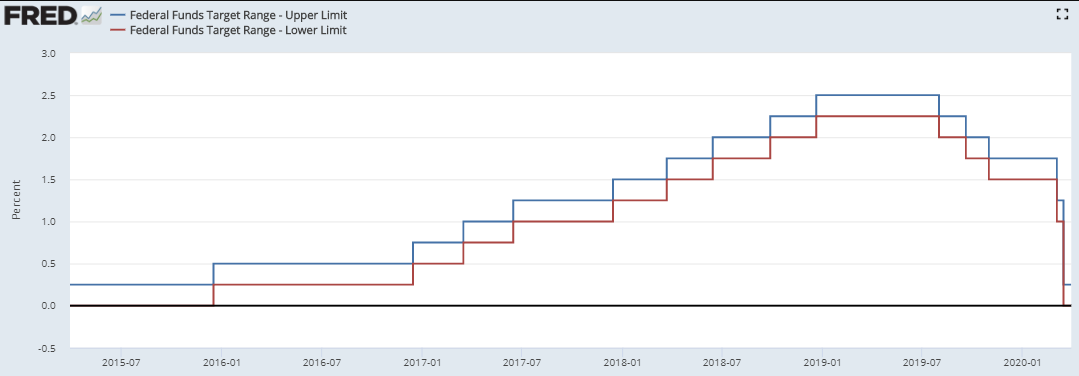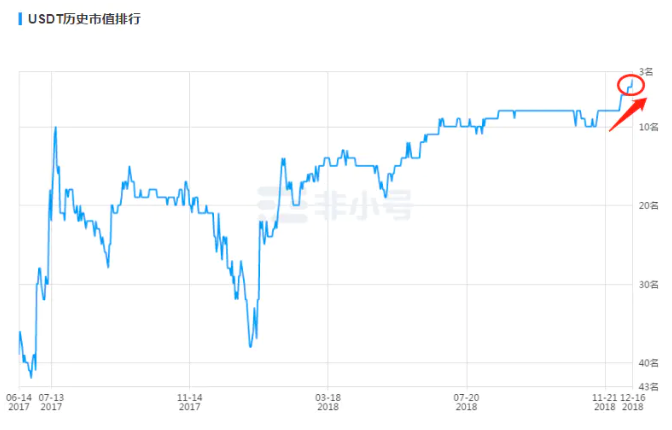In the era of negative interest rates, the USDT status is not guaranteed?
Author: Hash school – Adeline
0 interest rate is coming, will "negative interest rate" still be far behind?
Under the US dollar liquidity crisis caused by the continuous meltdown of the US stock market and large fluctuations in the financial market, the Fed hit a "loose combination punch" on the afternoon of March 15th. The temporary emergency meeting announced the restart of the QE "quantitative easing" policy by expanding Debt, to increase the market's money supply in disguise, opened the "big water" of 700 billion US dollars; at the same time violent interest rate cuts of 100 basis points, the Federal Reserve Fund rate was reduced to 0-0.25% range, officially opened the "zero interest rate era."
- Vitalik: The benefits of complete decentralization and "limited" centralization, the blockchain can do both
- Guangzhou City issued "Several Measures to Accelerate the Creation of a Digital Economy Innovation Leading City", many of which are related to blockchain
- Now, it takes 1 BTC to conduct a 51% attack on the BCH network for 1 hour

Federal Reserve Fund rate data source: Fed official website
In addition, after this, the Federal Reserve allowed banks to increase the leverage ratio to help deal with the situation of insufficient liquidity of U.S. Treasury bonds. Affected by this news, on March 25, the yield of the U.S. 1-month and 3-month Treasury bonds once fell into negative Value, which means that the US $ 17 trillion U.S. Treasury market is one step closer to negative yields.
In fact, several other major economies have even entered the "negative interest rate era"-the Bank of Japan ’s interest rate level has fallen to -0.1%, the European Central Bank ’s overnight deposit rate has fallen to -0.4%, the Bank of England ’s benchmark interest rate All recently reduced. Therefore, the market began to speculate that the US dollar interest rate will continue to decline under the continued increase in easing policies, and will soon join the "negative interest rate club."
What does this mean for stablecoins?
Whether it is the traditional financial market or the cryptocurrency market, we pay close attention to the impact of the zero interest rate of the US dollar and possible negative interest rates. Although there seems to be a natural barrier between the crypto market and traditional finance, after the stable currency anchored with the US dollar gradually dominates the market, the public chain begins to establish a connection with the US dollar.
From the perspective of issuers of stablecoins , especially USDT, USDC, TrueUSD and other stablecoins that are 1: 1 anchored with the US dollar, they are very sensitive to changes in the interest rate of the US dollar. The negative interest rate may bring a devastating blow.
Earlier, some media questioned whether the stable currency can maintain a 1: 1 anchor with the US dollar after the arrival of negative interest rates . This is not groundless.
Take Tether, the first USDT issuing company as an example. There are two main ways of making profits in Tether : one is the interest generated by the 1: 1 USD reserve in the bank, and the other is the transaction redemption fee (the user withdraws a 5% handling fee ).
According to Tether ’s daily announcement of USDT assets, Tether ’s US dollar reserve has reached 6.528 billion US dollars. If according to the current Tether company announcement, the current USDT reserve rate has been restored to 100%, according to the previous statement of Bitfinex CTO Paolo Ardoino, Tether ’s U.S. dollar reserves are basically cash and relatively safe fixed income investments like national debt. Well, before the USD 0 interest rate, we roughly estimate that the annual rate of return is about 1.5% -2.5%. Eventually this part will generate a profit of 98 million to 163 million US dollars, which is an important part of Tether's revenue.

Data source: Tether official website announcement
However, water can carry a boat, and it can also overwrite it. The Federal Reserve lowered the federal benchmark interest rate to a level close to zero, and the bank will also reduce the annualized rate of return on the deposit account, which means that the stable currency issuer will put the US dollar reserve in the bank for profit. This profit model will be invalid . Under negative interest rates, issuers of stablecoins need to advance their own funds to ensure that reserve deposits will not shrink.
This has long been a lesson in history-the Stasis stablecoin may be heard by few people today, but before it was the largest stablecoin issued in Europe, a total of about 31 million euros were issued. But under the European Central Bank's (ECB) zero interest rate policy, the euro-based stablecoin is completely uncompetitive. In the last annual financial statement (December 2018) released by Stasis, it shows that the income is 0 euros, but the expenditure is as high as 15 million euros. [1]
As the US dollar interest rate continues to fall, this profit model is destined to be unsustainable.
In this regard, Bitfinex ’s general consultant Stuart Hoegner stated in an interview with The Block that in addition to the US dollar, Tether also “reserves other cash equivalents, and may also include other assets and accounts receivable caused by Tether providing loans to third parties from time to time. As for the specific situation, Hoegner declined to disclose. Other stablecoin issuers including Paxos, TrustToken and Gemini have also stated that they will ensure a 1: 1 ratio, but no specific strategy is mentioned. [2]
Then we might as well guess two possible situations.
Negative interest rates may prompt issuers of stablecoins to seek higher-yielding assets and invest US dollar reserves in non-zero-risk investment vehicles . For example, as early as 2019, when interest rates were already showing signs of decline, Circle announced: "The future These funds may be invested in high-liquidity, AAA fixed income securities. "However, although the risk of AAA fixed income securities is low, it does not mean that there is no risk. At present, the entire stablecoin market is close to 7 billion US dollars. With a huge volume, the exit cost increases, so relatively, the stablecoin credit risk will further increase. How to balance credit risk and income will be a big problem.
Or start with transaction fees . Currently companies including Tether charge transaction redemption fees, but with the advent of zero interest rates and possible negative interest rates, stablecoin issuers may charge more fees to face reserves Shrinkage. But in the stablecoin market where the crowds are competing, users are sensitive to transaction costs, and the transfer of expenditure to stablecoin holders will have to face the problem of customer churn . From another perspective, negative interest rates will allow issuers to re-explore the profit model. Although at present, USDT, which is full of various doubts, occupies most of the stable currency market, but if the conversion of the profit model causes customer flow, it will There is a possibility that the industry will reshuffle. At the same time, other collateralized stablecoins may receive more attention in the future, such as Marker Dao's DAI and gold-linked PAX Gold.
From the perspective of stablecoin users, regardless of whether the issuer invests reserves in non-zero-risk investment vehicles or charges more transaction fees, there is a possibility of passing the risk on to users.
The storm has doubled again, can USDT survive it?
Today, with economic globalization, the whole body is often triggered, with few exceptions. Once the era of negative interest rates begins, stablecoins led by USDT will bear the brunt, which will cause the issuer's operating difficulties.
Looking back at the USDT these years, in fact, there have been constant disturbances along the way.
On October 15, 2018, USDT suffered a price collapse, falling from around US $ 1 to US $ 0.87, which fell by more than 12%, and was wildly sold by various exchanges. Coupled with a series of negative events such as over-issued doubts and difficulties in accessing the US dollar before and after, USDT's word of mouth has successively declined, other stable currencies have taken advantage of additional issuance, and various pessimistic voices have appeared in the media.
However, on November 1, 2018, Tether announced that it had established a partnership with the Deltec Bank in the Bahamas, and announced an asset certificate of approximately US $ 1.83 billion issued by the bank, which gave the investors a "heart-wrenching." "The panic that has lasted for more than half a month has eased. In addition, under the crypto bear market, USDT is still the main entry and exit of funds. This thunderstorm has not effectively shaken its leading position in the stable currency market , and even the market value has not fallen. On the contrary, according to non-small data, starting from December 3, 2018, the USDT market capitalization ranks from 8th to now has ranked 4th.

Data source: non-small
After half an year, USDT once again experienced a credit collapse. On April 25, 2019, New York State Attorney General Letitia James disclosed in a press release that the crypto exchange Bitfinex lost $ 850 million, and subsequently "appropriated" Tether's reserve funds to make up for the secret. Affected by this news, USDT's The price fluctuated abnormally: starting at 6 o'clock Beijing time on the same day, it fell 2.1% within 3 hours and fell to a minimum of US $ 0.985. USDC, PAX and other emerging stablecoins saw the surge in demand in the market overnight, and began to be issued frequently.
However, the thunder again did not allow these stablecoins to take advantage of the situation. The USDT market share did not significantly decrease. It fell only 1.33% on the day of the incident, fell to 96.94%, and rebounded to 97.98% the next day. .
The repeated thunderstorms and the questionable reserve situation since its issuance have failed to shake the position of USDT. The reason is that stable currency investors with cryptocurrency nature have a high tolerance for risks. Most users will pay more attention to convenience, liquidity and other practical experiences, and have strong trading habits.
But this time and again the crisis is like straw on the camel. If the number of straw is too large, it will still be crushed. If the negative interest rate environment persists for too long, a single profit model will lead to operational difficulties, which will undoubtedly become a major challenge for the stable currency market, some may survive, and some may escalate.
But this time, can the stablecoin overlord USDT hold on?
appendix
[1] https://www.theblockcrypto.com/daily/59996/negative-interest-rates-have-arrived-in-the-us-stablecoin-issuers-say-theyll-maintain-11-parity-with-the -dollar
[2] https://www.fxstreet.com/cryptocurrencies/news/what-near-zero-interest-rates-mean-for-stablecoin-and-why-it-wont-hamper-its-growth-202004021138
We will continue to update Blocking; if you have any questions or suggestions, please contact us!
Was this article helpful?
93 out of 132 found this helpful
Related articles
- Featured | Billionaires: Bitcoin's chances of becoming a global reserve currency have increased
- 16 cases from the bottom of the Chinese blockchain platform: the application layer is clearly differentiated
- Mining Monthly Report: The market plunged and the computing power was lowered. Where should miners go?
- Opinion | The evolution of money in the New Crown epidemic: Cryptocurrencies are becoming more attractive
- The three death spirals of mining: two pictures to understand what happened to Jianan?
- Contribution takes "credit currency", a town in Hangzhou explores a new way of blockchain rural governance
- Viewpoint | The birth of blockchain has financial attributes and is a frontier in the investment field






